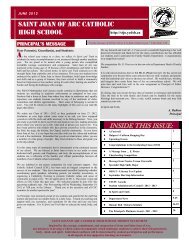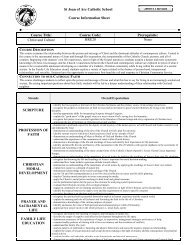Example 3 – Solving a problem using angle properties Determine ...
Example 3 – Solving a problem using angle properties Determine ...
Example 3 – Solving a problem using angle properties Determine ...
You also want an ePaper? Increase the reach of your titles
YUMPU automatically turns print PDFs into web optimized ePapers that Google loves.
Unit6Workbook.notebook<br />
May 03, 2013<br />
<strong>Example</strong> 3 <strong>–</strong> <strong>Solving</strong> a <strong>problem</strong> <strong>using</strong> <strong>angle</strong> <strong>properties</strong><br />
<strong>Determine</strong> the measure of<br />
Justify your answer with <strong>properties</strong> used in chart below.<br />
May 29:02 AM<br />
7.2 Angle Properties of Parallel Lines<br />
A line that intersects a pair of parallel lines is called a transversal. When <strong>angle</strong>s<br />
are formed by two parallel lines and a transversal:<br />
Corresponding Angles<br />
are equal<br />
“F Pattern”<br />
Alternate Angles<br />
are equal<br />
“Z Pattern”<br />
Interior Angles have a<br />
sum of 180°<br />
“C Pattern”<br />
May 29:03 AM<br />
1
Unit6Workbook.notebook<br />
May 03, 2013<br />
Let’s find the corresponding, alternate and interior <strong>angle</strong>s:<br />
Corresponding Angles (F Pattern):<br />
c = d =<br />
e = f =<br />
Alternate Angles (Z Pattern):<br />
e = f =<br />
Interior Angles (C Pattern)<br />
e + ___ = 180° f + ___ = 180°<br />
May 29:06 AM<br />
<strong>Example</strong>:<br />
Find the missing <strong>angle</strong>s.<br />
a = b = c =<br />
May 210:36 AM<br />
2
Unit6Workbook.notebook<br />
May 03, 2013<br />
May 210:36 AM<br />
3
















